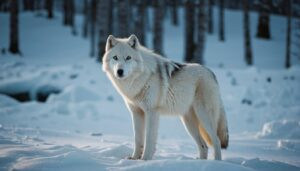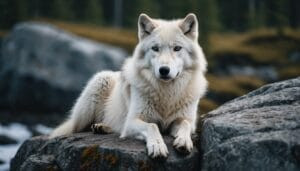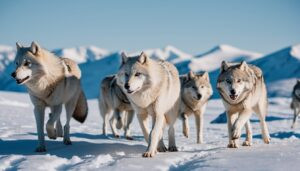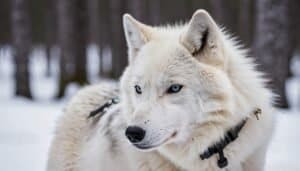Introduction
Field research on Arctic wolves presents numerous challenges, ranging from environmental and logistical issues to behavioral and safety concerns. This article delves into these difficulties, exploring how researchers navigate extreme temperatures, harsh weather, transportation hurdles, and equipment needs
We will also discuss the impact of Arctic wolf behaviors, safety precautions, data collection methods, and the influence of climate change on research efforts
Environmental and Logistical Challenges
Conducting field research on Arctic wolves requires overcoming significant environmental and logistical challenges. Researchers must navigate extreme temperatures, harsh weather conditions, transportation hurdles, and the need for specialized equipment and supplies
Extreme Temperatures
One of the most formidable challenges in Arctic wolf research is dealing with extreme temperatures. The Arctic region is characterized by prolonged periods of frigid weather, with temperatures often plunging well below freezing
These extreme conditions can have several impacts on research efforts:
Human Endurance: Researchers must be physically prepared to withstand the severe cold. Prolonged exposure to such temperatures can lead to frostbite and hypothermia, necessitating proper winter gear, including insulated clothing, thermal layers, and reliable heat sources
Equipment Functionality: Many electronic devices and research equipment are not designed to function optimally in sub-zero temperatures. Batteries drain faster, and delicate instruments can malfunction or break. Researchers need to use specially designed equipment or modify existing tools to ensure they operate correctly in the cold
Sample Preservation: Biological samples collected in the field, such as blood or tissue samples, can be compromised by freezing temperatures. Ensuring that these samples are stored and transported without degradation requires careful planning and the use of appropriate containers and preservatives
Harsh Weather Conditions
In addition to the cold, researchers must contend with other harsh weather conditions, including strong winds, heavy snowfall, and blizzards. These conditions can pose several problems:
Reduced Visibility: Snowstorms and blizzards can drastically reduce visibility, making it difficult for researchers to locate and track Arctic wolves. This can hinder data collection and increase the risk of getting lost in the vast, featureless landscape
Travel Disruptions: Heavy snowfall and strong winds can make travel dangerous or impossible. Researchers often rely on snowmobiles, sleds, or even aircraft to reach remote study sites. Harsh weather can ground flights and make overland travel treacherous, leading to delays and interruptions in the research schedule
Shelter and Safety: Maintaining safe and stable shelter in such conditions is crucial. Researchers must ensure their camps or field stations are robust enough to withstand severe weather, which involves using high-quality tents, sturdy structures, and securing adequate heating and food supplies
Transportation and Accessibility
The remote and isolated nature of the Arctic poses significant transportation and accessibility challenges for researchers:
Remote Locations: Arctic wolves inhabit some of the most remote and inaccessible regions on Earth. Reaching these areas often requires extensive planning and coordination, involving multiple modes of transport, such as aircraft, boats, and ground vehicles
Logistical Coordination: Coordinating transportation to and within the Arctic is complex and costly. Researchers must arrange for flights, secure permits, and ensure that they have reliable means of transportation for the duration of their study
This often involves working with local authorities, indigenous communities, and logistics companies experienced in Arctic operations
Limited Infrastructure: The lack of infrastructure in the Arctic further complicates logistics. There are few roads, airports, or facilities, meaning researchers must be self-sufficient and prepared to set up their own camps, communication systems, and supply chains
Equipment and Supplies
Ensuring that researchers have the necessary equipment and supplies is crucial for the success of Arctic wolf field studies:
Specialized Gear: Researchers need specialized gear to survive and work effectively in the Arctic environment. This includes cold-weather clothing, reliable tents, and cooking equipment that can function in freezing temperatures
Scientific Instruments: The instruments used for tracking and studying Arctic wolves, such as GPS collars, camera traps, and radio telemetry equipment, must be able to withstand the harsh conditions. Researchers also need to carry backup equipment and spare parts to address any malfunctions
Supply Management: Managing supplies is critical, as resupplying in the Arctic is difficult and expensive. Researchers must carefully plan their food, fuel, and medical supplies, ensuring they have enough to last the entire duration of their fieldwork, with contingencies for delays or emergencies
Navigating these environmental and logistical challenges requires meticulous planning, substantial resources, and a deep understanding of the Arctic environment. Researchers must be adaptable and prepared to face unforeseen difficulties to successfully conduct their studies on Arctic wolves
Behavioral and Safety Challenges
In addition to environmental and logistical difficulties, researchers face significant behavioral and safety challenges when studying Arctic wolves. Understanding wolf behavior and ensuring the safety of both researchers and animals are crucial aspects of field research in the Arctic
Tracking and Observation
Tracking and observing Arctic wolves in their natural habitat presents unique challenges due to their elusive nature and the vast, rugged terrain they inhabit:
Elusiveness: Arctic wolves are naturally wary of humans and tend to avoid contact. This makes direct observation difficult. Researchers must rely on a combination of methods, such as GPS collars, camera traps, and snow tracking, to monitor wolf movements and behaviors without disturbing them
Large Territories: Arctic wolves have large home ranges, often covering hundreds of square miles. Tracking them across such extensive areas requires significant time and effort. Researchers need to be prepared for long, strenuous journeys on foot or by snowmobile to follow wolf packs
Behavioral Patterns: Understanding the behavioral patterns of Arctic wolves, such as hunting, social interactions, and denning activities, is crucial for comprehensive research. This requires continuous observation and data collection over extended periods, often in harsh conditions
Interaction with Human Presence
The presence of researchers can influence the behavior of Arctic wolves, potentially affecting the accuracy of the data collected:
Disturbance: Human presence can disturb the natural behavior of wolves, causing them to alter their movements or abandon certain areas. Researchers must minimize their impact by maintaining a safe distance and using non-invasive monitoring techniques
Habituation: There is a risk of wolves becoming habituated to humans, which can lead to changes in their natural behavior and increased vulnerability to poaching or other threats. Researchers need to strike a balance between collecting data and ensuring that wolves remain wild and wary of human contact
Ethical Considerations: Ethical considerations are paramount in wildlife research. Researchers must ensure that their methods do not harm the wolves or disrupt their natural lives. This involves obtaining proper permits, following ethical guidelines, and prioritizing animal welfare
Wildlife Encounters
The Arctic environment is home to various wildlife species, some of which pose potential dangers to researchers:
Polar Bears: Polar bears are a significant threat in the Arctic, as they are both curious and potentially aggressive. Researchers must be vigilant and prepared to encounter polar bears, carrying bear spray and other deterrents, and knowing how to respond to bear encounters
Other Predators: Besides polar bears, researchers may also encounter other predators like wolverines and foxes. While these animals are less dangerous, they can still pose risks, especially if they are protecting their territory or young
Safety Protocols: To mitigate risks, researchers must follow strict safety protocols, including traveling in groups, maintaining constant communication, and having emergency plans in place. Training in wildlife behavior and first aid is essential for ensuring safety in the field
Personal Safety Measures
Ensuring the personal safety of researchers is a top priority, given the remote and harsh conditions of the Arctic:
Cold-Related Injuries: Frostbite and hypothermia are significant risks in the extreme cold. Researchers must wear appropriate clothing, take regular breaks to warm up, and monitor each other for signs of cold-related injuries
Isolation: The isolation of Arctic field sites can be mentally and physically challenging. Researchers must be prepared for long periods of solitude and limited contact with the outside world
This involves psychological preparation, maintaining regular communication with support teams, and having recreational activities to combat isolation
Medical Emergencies: In the event of a medical emergency, immediate evacuation may not be possible due to the remoteness of the study sites. Researchers need to carry comprehensive medical kits, have training in wilderness first aid, and have clear evacuation plans in place
By addressing these behavioral and safety challenges, researchers can conduct effective and ethical studies on Arctic wolves while ensuring their own safety and the welfare of the animals they study
Data Collection and Climate Impact
Collecting accurate data and understanding the impact of climate change are crucial components of field research on Arctic wolves. Researchers must employ effective monitoring techniques and account for the rapidly changing Arctic environment to ensure their findings are reliable and relevant
Monitoring Techniques
Effective data collection requires a combination of traditional and advanced techniques to monitor Arctic wolves in their natural habitat:
GPS Collars: One of the most common methods for tracking Arctic wolves is using GPS collars
These collars provide precise location data, allowing researchers to monitor the movements and behavior of individual wolves over time. The data collected helps in understanding their home ranges, migration patterns, and social dynamics
Camera Traps: Camera traps are strategically placed in areas frequented by wolves, such as den sites and hunting grounds
These cameras capture images and videos, providing valuable insights into wolf behavior, pack interactions, and population dynamics without disturbing the animals
Snow Tracking: In the winter months, researchers use snow tracking to follow wolf footprints and other signs, such as scat and kill sites
This method helps in understanding their hunting strategies, prey selection, and movement patterns. While labor-intensive, snow tracking provides direct evidence of wolf activity and interactions with their environment
Radio Telemetry: Radio telemetry involves fitting wolves with radio collars and tracking them using handheld receivers
This method is useful for short-term studies and in areas where GPS signals may be unreliable. It allows researchers to locate wolves in real-time and observe their behavior directly
Ensuring Reliable Data
Ensuring the accuracy and reliability of data collected in the harsh Arctic environment is a significant challenge:
Data Quality: Researchers must regularly check and calibrate their equipment to ensure data accuracy
This includes verifying the functionality of GPS collars, camera traps, and other monitoring devices. Regular maintenance and troubleshooting are essential to prevent data loss and ensure continuous monitoring
Data Management: Collecting large volumes of data requires effective data management strategies. Researchers must organize, store, and analyze data systematically, often in real-time, to identify trends and make informed decisions
Using robust software and data management systems helps in handling the complexity and volume of data collected
Minimizing Bias: To minimize bias in their findings, researchers must design their studies carefully, considering factors such as sampling methods, study duration, and environmental variables
They must also account for the potential influence of their presence on wolf behavior and take steps to mitigate it
Changing Habitats
Climate change is rapidly altering the Arctic environment, impacting the habitats and behaviors of Arctic wolves:
Melting Ice and Snow: The melting of ice and snow due to rising temperatures affects the availability of prey and the movement patterns of Arctic wolves
Researchers must account for these changes when studying wolf behavior and ecology. For example, shifts in the distribution of prey species, such as caribou and muskoxen, can influence wolf hunting strategies and pack dynamics
Habitat Loss: As the Arctic environment changes, the loss of suitable habitat poses a significant threat to Arctic wolves. Researchers must monitor habitat changes and understand their impact on wolf populations
This involves studying vegetation shifts, changes in prey availability, and the encroachment of human activities into previously undisturbed areas
Adaptive Behaviors: Arctic wolves may exhibit adaptive behaviors in response to changing environmental conditions
Researchers must document these adaptations to understand the long-term implications of climate change on wolf populations. This includes studying changes in diet, hunting strategies, and pack structures
Long-Term Effects on Research
The long-term effects of climate change on Arctic wolf research are profound and multifaceted:
Evolving Research Focus: As the Arctic environment continues to change, researchers must adapt their focus to address emerging challenges and questions
This may involve studying new behaviors, tracking shifts in prey populations, and understanding the broader ecological impacts of climate change on the Arctic ecosystem
Collaboration and Funding: Long-term research requires sustained collaboration and funding. Researchers must work with governmental and non-governmental organizations, indigenous communities, and international partners to secure the necessary resources and support
This collaborative approach ensures that research efforts are comprehensive and well-coordinated
Policy Implications: The findings of Arctic wolf research have important policy implications. Researchers must communicate their results to policymakers and the public to inform conservation strategies and climate action
Effective communication and advocacy are essential for translating research into meaningful conservation efforts
By employing robust monitoring techniques, ensuring data reliability, and accounting for the impacts of climate change, researchers can conduct comprehensive and impactful studies on Arctic wolves. Understanding these challenges is key to preserving the delicate balance of the Arctic ecosystem and protecting the future of Arctic wolves
Conclusion
Conducting field research on Arctic wolves presents a series of intricate challenges that researchers must navigate to ensure successful and ethical studies. These challenges encompass environmental, logistical, behavioral, safety, data collection, and the profound impact of climate change
Environmental and Logistical Challenges include extreme temperatures that test human endurance and equipment functionality, harsh weather conditions that reduce visibility and disrupt travel, and the remote, inaccessible nature of Arctic wolf habitats
Researchers must be well-prepared, with specialized gear and meticulous logistical coordination to overcome these obstacles
Behavioral and Safety Challenges involve the elusive nature of Arctic wolves, the influence of human presence on wolf behavior, and the potential dangers posed by other wildlife like polar bears. Researchers must use non-invasive monitoring techniques and follow strict safety protocols to protect both themselves and the animals
Data Collection and Climate Impact highlight the importance of employing advanced monitoring techniques, ensuring data reliability, and understanding the changing Arctic environment
GPS collars, camera traps, snow tracking, and radio telemetry are essential tools for gathering accurate data. Climate change, with its impact on habitats and wolf behaviors, adds another layer of complexity, requiring researchers to adapt their focus and collaborate widely
By addressing these multifaceted challenges, researchers contribute to a deeper understanding of Arctic wolves and their environment
Their findings not only advance scientific knowledge but also inform conservation efforts and climate policies, helping to protect these magnificent creatures and their fragile Arctic home










